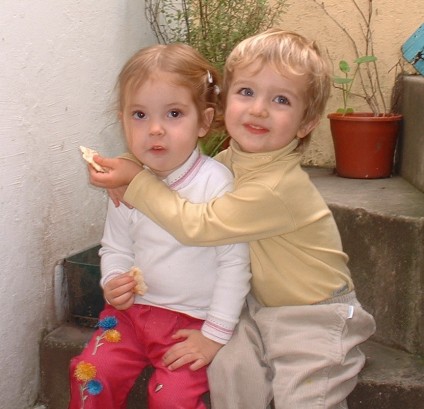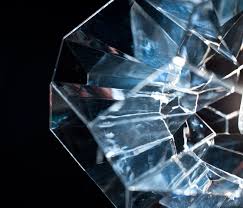
This picture belongs to our family album and it is used as an illustration. It does not represent the real children mentioned in this research.
Warning: You are about to depart into an incredible flight. This is a longread post, much worth every word of it. Get yourself a coffee, turn off your phone and be ready to enjoy one of the most healing love stories ever. It is 100% real, I only changed the children’s names.
The effusive kiss. Alice, 2 years 9 months. Pete, 2 years 11 months.
Hypothesis: when a young child attending a play group is seen and accepted for what she is, and not for what she is missing, her self-confidence is meaningfully fostered and a proper field is opened in the group for shared love and compassion.
Alice has come to play for 8 months. She is a big sized girl, usually wearing colorful cloths. Her big black curls frame her enormous black eyes and her beautiful chubby cheeks face.
It took her around 5 months to be ready to stay within the play area and move around leaving her mother´s lap. Before that she only played here and then with the toys that were near her hand reach. At snack time she would gently move her mother´s hand as an extension of her arm to make her grab a cookie and feed her into the mouth. She would also use her mother´s arm as a tool to reach and interact with toys.
No eye contact, no words, no further interactions.
I thought socialization might be an intimidating challenge for Alice in a particularly active, talkative, enthusiastic two years old play group, whose leader is Pete. He is the little one the rest admires and fears at the same time but I will tell you more about him later. Back to Alice now.
I asked her mother whether at home she played in the same way as in the play group. Her answer made me a bit concerned:
– No, she enjoys here. At home she is even more still.
Then I talked to the mother.
She told me when Alice was 14 months she had asked the pediatrician whether her child had Autism. He said: “I don’t think so, give her time”. I felt relieved. Giving time is my favorite choice. It includes accepting the child as she is, sending an acknowledgement message to her which I firmly believe will nurture her best potential.
But what if that time was over and she really needed some early diagnose now? I made a few suggestions as to “stop doing for her” the things she can do for herself (mainly feeding and playing) and fostering a new vision of her child: as a capable, trustworthy little human unfolding her own self at her own time.
Simultaneously a professional started diagnosing Alice, saw her for about two months once a week and then offered parents some guidelines that really helped.
In the meanwhile I tended to approach her differently than how I did with the rest of the children (regarding free play, autonomy and social interactions). I felt tempted to “help her out” a little, little bit (that is what I said trying to convince myself). She has the sweetest way of getting you to do what she wants but I knew this was not the best for her. So I had a big challenge to face.
One day she wanted to grab a toy beyond her reach. So she pulled her mother´s arm wanting her to grab it for her.
I said:
“No, mom is not grabbing that for you. If you want it, you can grab it yourself”.
She got distressed. She went to the ground but not in the normal tantrum way (facing earth with body and face). She did it as a little baby would do when placed down by a parent, on her back. She started mourning. It was a deep and at the same time suffocated mourning.
Heartbreaking. My mouth and lips got dry. Other parents got restless; the mother was clearly trusting me but suffering within.
I approached Alice and broadcasted her situation with a blind confidence in what I have learnt. I wanted to console her, to soothe her, to do for her, to solve her struggle with all my heart. But this time I just described what was going on: “you want mommy to grab a toy for you, I said she wouldn´t, you did not like that, you are laying down mourning, I can understand you, I am here for you to cry all you need to”.
The mother looked puzzled and sad. We all were. Time run out and they left leaving a bitter taste in the air.
That week I would think very often of what happened and I convinced myself I did the right thing repeating a mantra within: trust her… trust her… trust her.
Thereafter Alice started getting into the play field with autonomy and she demonstrated that even when not talking nor looking into the eyes of her playmates, she was 100% into the group interactions.
Week 1:
Someone asking for a drum stick? She would pick it up and approach it to the requesting child. (Mom still inside the play area).
Week 2:
Someone running about with a just grabbed toy looking back and searching for a follower? She would get into the running circle and run, run, run. (Mom sitting with other parents and only exceptionally needed back from then onwards).
Week 3:
Someone playing with a different set of socket toy? She would slide her toy next to a boy´s hand and grab his puzzle to give a try to new combinations of sizes and shapes. She clearly enjoys sitting and indirectly exchanging with this particular child: Pete. He is the most talkative, risk-taking, active, expressive and puzzle solver genius in the group.
Then two weeks ago Alice´s father came along (mother too). He had the day free. Alice looked particularly happy about this.
After the “running circle marathon game” this group had created and enjoyed for many weeks, Pete approached Alice form one side and grabbed her firmly from the neck. His mother stood up and called out his name loudly wanting to stop him. It was not the first time that Pete expressed his inner impulses in a strong physical contact with a playmate and his mother worries about that.
I stopped her as fast and best as I could. Alice was not afraid. Pete was not in a rage. Something different was going on. This interaction was gold for me.
Pete was still holding Alice from the neck with his left hand. Now he embraced her with his right arm and pulling her face towards his mouth he sink his lips into her chubby left cheek and KISSED her. Just like that, a capital kiss.
Everyone got still.
Alice remained processing the experience for a few seconds. Still facing front (without turning face to face towards him), she bend her chest and lowered her left shoulder towards his face, reaching his lips with her cheek. And he kissed her, kissed her and kissed her one more time.
Grownups breathed relieved, the other children resumed their play, Alice mother´s was holding a giant smile in her face and her father was experiencing in an early stage what most fathers have to wait until their kids are 15… Another boy loved his girl as much as he did.
What a debut to enter socialization! This was the first time (in her life?) Alice offered her own body to get in touch with another child in a direct way, having a clear intention and expecting an interaction. No intermediary. No third-party adult to do for her.
From then on, she has a first sketch to construct her own path into life.
How is Alice doing?
Are there words? Only murmurings… for now.
Is there eye contact? Very little, very short… for now.
But I don’t worry a bit about that. I have other intrigues.
My main question is: what made Alice available to dare entering into socialization?
There is not a single answer for that, for sure.
I know. Anyhow, which where the main influencing factors?
Was it time and trust?
Was it parents asking for professional help?
Was it Alice meeting frustration in a respectful and caring environment, that day that I remained really firm for the (probably) first time?
Was it Pete?
And what, what, what made Pete do what he did?
Was it love?
Everything infants and toddlers do meets a developmental need. That is why we set a safe environment for free movement and play, we do not over-stimulate nor interrupt free play and we do our best to acknowledge feelings and struggles with respect.
If everything a little child does is a reflection, reaction and resound of his inner map towards unfolding humanness, then what if being humane, compassionate and loving IS a human developmental need?
What if in a free educational environment not only physical, emotional and mental unfolding is manifested? Could we infer that a spiritual unfolding need pushed Pete to interact with Alice as he did?
If Pete´s mothers would have succeeded in stopping him grabbing Alice from the neck we would have probably not known. And the mother would have admonished him for “misbehaving”, Pete´s natural spiritual impulse would have probably been interrupted.
But this is not what happened. He was given time and chance to manifest his inner urge.
So for now my answer is YES. Spirituality is a human developmental need.
And I only can prove that by empirical observation and experience.
What would happen if we realize spirituality is the missing key to revolutionize education?
More of that in a future post.




